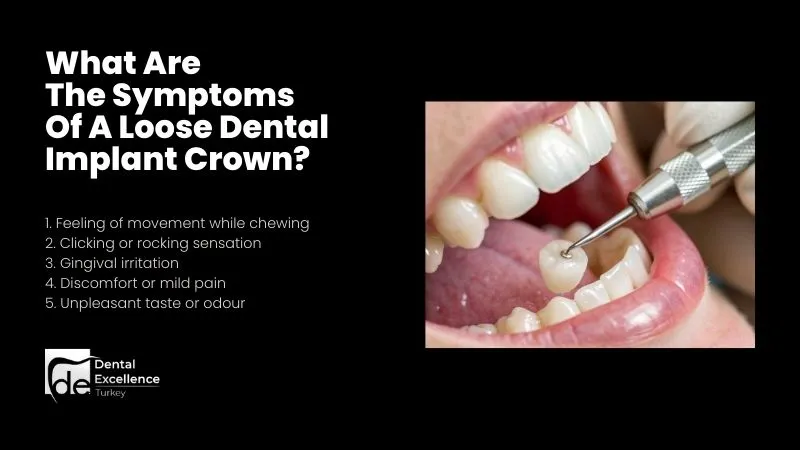What are the symptoms of a loose dental implant crown?
All About Dental Treatments in Turkey

Patients often think that implant has failed when they notice that implant crown has loosed. In fact, most of the time, the body of implant, which is placed in the jawbone, is intact. The moving part is the crown or the screw that provides the connection.
Dental implant system consists of three parts: the implant body, which is inserted into the jawbone, the abutment (spacer) that connects to it, and the crown on top. When one of these connections is weakened, the crown starts to move. A loose crown does not necessarily mean loss of the implant. However, in order to avoid problems, you should definitely make an appointment with a dentist.
Common symptoms of a loose implant crown
1. Feeling of movement while chewing
Normally, an implant crown should be as firm and stable as a natural tooth. If you have a loose dental implant crown, you may feel movement when eating or only when chewing hard foods.
2. Clicking or rocking sensation
If the crown is not well seated on the abutment, it will cause a ‘clicking’ sound or a rocking sensation. This can damage the implant system and surrounding tissues. In addition, these micro-movements negatively affect the patient’s comfort.
3. Discomfort or mild pain
A blunt pressure or pain may be felt when chewing due to a loose dental crown. The pain is usually not caused by the bone but by the gum or adjacent teeth.
4. Gingival irritation
A loose implant crown rubs against the gum and irritates it. Patients often complain of redness, tenderness, or bleeding when brushing.
5. Unpleasant taste or odour
When dental crown becomes loose, food residues and bacteria enter the space between the crown and the abutment over time. This leads to bad breath or bad taste. It may cause infection in the gums or damage to implant.
Why do dental implant crowns become loose?
Implant crowns can loosen over time, and there are many reasons for this. Here are some of them:
Abutment screw loosening
The abutment screw is a critical part that connects the crown to the implant screw. This part can loosen over time due to daily chewing forces. Sometimes, it may not be tightened enough at the time of initial insertion.
Loss of retention in cement-retained crowns
Some crowns are fixed with adhesive (dental cement) rather than screws. Over time, this cement may weaken. When the cement loses its retention, the crown starts to separate from the abutment and becomes loose.
Excessive or unbalanced occlusal forces
Excessive load on a single implant can occur due to an unbalanced bite or tooth clenching. This leads to loosening of the implant crown.
How is a loose dental implant crown treated?
Tightening or replacing the abutment screw
If the implant crown is screwed in and the screw is loose, the dentist removes the crown and checks the screw. If necessary, a new screw is inserted, or the loose screw is re-tightened.
Re-cementation of the crown
For crowns fixed with cement, the adhesive is renewed, and the crown is cemented again. A better quality cement can be chosen to ensure a tight fit for a longer period of time.
Evaluation of the abutment
Sometimes the problem is caused by the abutment itself. In this case, the abutment is re-prepared and ideally positioned.
Advanced intervention
If the implant is stable, it is easy to replace the dental crown. If the implant body also moves, the situation is more serious. In this case, the dentist assesses the condition and removes the implant if necessary. The underlying problem is corrected, and a new implant is placed.
What happens if a loose implant crown is not treated?
Initially, mild pain and discomfort increase over time and make chewing difficult. In addition, the space between the crown and the abutment becomes a gateway for bacteria. Over time, these bacteria are likely to cause an infection called peri-implantitis. Peri-implantitis is a common cause of implant failure. Therefore, taking crown loosening lightly may not be a good choice. If you think that the implant crown has loosened, you should contact your dentist as soon as possible to avoid a more troublesome and costly process.
How to differentiate between a loose crown and a loose implant
It is not possible for patients to distinguish between the two. If you have a loose implant crown, only the part that looks like a tooth moves. If you have a loose implant, the whole structure moves. If your implant is loose, you will feel more severe pain. During the consultation, the dentist will make a diagnosis and implement a treatment plan.
Can a loose crown be tightened again?
Yes. Loose crowns can be tightened or re-clamped. If the dental crown needs to be replaced, it can be easily replaced.
How often do implant crowns become loose?
Loose implant crowns are not common with modern systems. However, screw loosening is a common problem in screw-retained systems. This risk is especially higher in individuals who have the habit of clenching their teeth. Patients with this habit should use a dental protector to prevent loose crowns.
Is a loose dental implant an emergency?
A loose crown is not an emergency, but it should be treated without delay. With early intervention, the problem can be solved simply. You do not want to face a more complex problem in the long term. The important detail is: if the implant body is also mobile, a dental check-up is required as soon as possible.
START YOUR JOURNEY
Tell our specialist dentists about your teeth and get a free treatment plan.











